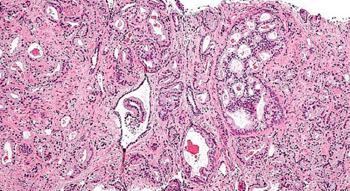Prostate Cancer Biomarkers Identified in Seminal Fluid
By LabMedica International staff writers
Posted on 18 Jun 2014
Improved diagnosis and management of one of the most common cancers in men, prostate cancer, could result from discovery that seminal fluid contains biomarkers for the disease.Posted on 18 Jun 2014
The presence of certain small ribonucleic acids (miRNA) in seminal fluid indicates not only whether a man has prostate cancer, but also the severity of the cancer, which would be an improvement on the commonly used prostate specific antigen (PSA) test which is not by itself ideal to test for the cancer.

Image: Histopathology micrograph of prostatic acinar adenocarcinoma, the most common form of prostate cancer (Photo courtesy of Nephron).
Scientists at the University of Adelaide (Australia) collected seminal fluid (SF) samples attending a Urology Outpatient clinic. Two RNA pools, representing groups of men with low/intermediate risk cancer or men without cancer, were compared. Men in both groups had elevated serum PSA levels to increase the likelihood of identifying miRNA biomarkers that would provide additional diagnostic information.
RNA was extracted using Trizol reagent (Life Technologies; Carlsbad, CA, USA) and cleaned up with RNeasy Mini kits (Qiagen; Hilden, Germany). Deep sequencing using the TruSeq Small RNA work flow (Illumina; San Diego, CA, USA) was used to analyze the small RNA population in the non-sperm cellular fraction of SF, which includes prostatic epithelial, urothelial, and inflammatory cells.
Hierarchical clustering based on these miRNAs yielded two major branches one of which was characterized by higher levels of the SF miRNAs and was largely composed of men with biopsy proven disease and the other characterized by lower SF miRNA levels and men with negative biopsies. These findings support the concept that individual SF miRNAs or an SF miRNA signature could be useful diagnostic tools.
Luke A. Selth, PhD, the lead author of the study said, “The presence of these microRNAs enabled us to more accurately discriminate between patients who had cancer and those who didn't, compared with a standard PSA test. We also found that the one specific microRNA, miR-200b, could distinguish between men with low grade and higher grade tumors. This is important because, as a potential prognostic tool, it will help to indicate the urgency and type of treatment required.” The study was published on May 23, 2014, in the journal Endocrine Related Cancer.
Related Links:
University of Adelaide
Life Technologies
Qiagen














